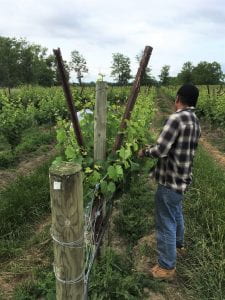Updated: 5/4/20
Much confusion exists about the availability for work of H-2A workers who are newly arriving from a foreign country. This post will attempt to clarify the issue.
14-day Quarantine
Early in the COVID-19 pandemic the U.S. Centers for Disease Control (CDC) issued guidance to people returning to the U.S. from international travel. The guidance calls for people to stay home, avoid contact with others, and monitor their health for 14 days following travel abroad. This self-imposed quarantine is intended to see if the person is infected by the coronavirus and to prevent them from spreading it in their community. Everyone coming into the country should observe this period of quarantine.
Essential Business and Employees
The governor of New York issued the PAUSE order which, among other things, closed most businesses by requiring 100% workforce reductions except for those that are deemed essential. Essential businesses are exempt from workforce reductions and their employees can continue to work. As stated on NYS Ag & Markets website: “Food producing farms, fisheries, operations that care for animals, farmers’ markets … are exempt from the state’s guidance for workforce reduction.” H-2A employees arriving to work in these essential farm businesses are allowed to work in New York. The state advises essential businesses to “implement rules that help facilitate social distancing of at least six feet” at work and to “maintain a clean and safe work environment.”
The NY Department of Health (NYSDOH) issued guidance on April 7, 2020 requiring quarantine for “persons who, in the past 14 days, have traveled to a country for which the Centers for Disease Control and Prevention (CDC) has issued a Level 2 or Level 3 Health Notice.” Most countries in the world are currently list as Level 2 or 3. This same document also says that individuals identified as “essential” employees may be allowed to work. In an earlier guidance document, NYSDOH articulated the conditions under which essential personnel could work while under quarantine:
- Working from home would not be feasible for job duties;
- Personnel are asymptomatic;
- Personnel quarantine themselves when not at work;
- Personnel undergo temperature monitoring and symptom checks upon arrival to work and at least every 12 hours while at work, and self-monitor (i.e. take temperature, assess for symptoms) twice a day when at home;
- Personnel required to interact with individuals within 6 feet should wear a facemask while working for 14 days following the last exposure;
- Personnel whose job duties permit a separation of greater than 6 feet should have environmental controls in place to ensure adequate separation is maintained, and do not need to wear a facemask;
- If personnel develop symptoms consistent with COVID-19 (e.g., fever, cough, or shortness of breath) while working, they should immediately stop work and isolate at home; and
- Testing should be prioritized for essential personnel with symptoms.
Reconciling Quarantine and Essential Work
Foreign guest workers in the H-2A program are arriving in increasing numbers in New York at this time, many from foreign countries. These employees are needed right away to help farms prepare for the growing season and to produce the food on which our civilization depends. Farm management and newly arriving H-2A employees must take steps to enable employees to work while also observing social distancing as much as possible, especially during that first 14 days after arrival from a foreign country. These 14-day quarantine steps may include:
- Have newly arrived workers live in housing separate from the rest of the workers.
- Discourage visiting. New arrivals should stay away from everyone else on the farm and others from the farm or elsewhere should not be visiting them.
- Assign work to new arrivals that can be completed separately from others.
- Purchase supplies for the newly arrived workers and deliver to them at their housing. Newly arrived workers should not be going to the store or otherwise interacting in the community, whether using farm transportation or other services.
- Arrange for food deliveries. Some farms have set up routine systems for ordering food and having it delivered to the farm.
- Provide face coverings. County health departments, 4-H, and the Cornell Farmworker Program are all helping to provide face coverings for farms.
Of course, it’s important to educate new arrivals about basic COVID-19 prevention and take action steps to prepare the farm. See this housing guide from Washington State, find a produce farm webinar and presentation at the Cornell Ag Workforce website, and a resource hub at Cornell’s EDEN website.
Even after the 14-day quarantine period, farm management can take action to strategically promote social distancing. For example, some growers are working with their employees to separate into “family” groups, not necessarily as real family members but rather as convenient, close-knit small groups of employees. These groups live and work together but separate as much as possible from other “families” of employees at the workplace and in housing. In this way the risk of infection is reduced between “families” and there is a better chance to isolate an infection and limit it to only one “family” group.
Bottom line, H-2A workers newly arriving from foreign countries are essential and can work right away in New York. At the same time, farmers and arriving employees must work together to maximize social distancing at work and home, especially for the first 14 days.
_________________________________________________________________________________
By Richard Stup, Cornell University. Permission granted to repost, quote, and reprint with author attribution.
The post Arriving H-2A Workers: Reconciling Isolation and Essential Status appeared first in The Ag Workforce Journal


